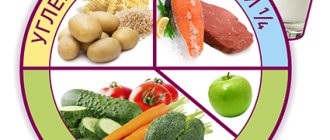Your baby has just celebrated his first “anniversary” - he turned one year old. He has learned a lot this year. Should his eating style now change?
Perhaps we can say that your baby has entered a transitional stage in nutrition. He is no longer a baby now. The baby will become more and more familiar with the “food environment” and will become closer to adults in his eating habits and preferences. But it takes some time for the baby to gradually adapt to a new style of eating.
By this age, great changes have also occurred in the baby’s digestive system. Firstly, he has already acquired his own teeth. As a rule, by the age of 1 year, children have 6-10 milk teeth. The baby's chewing skills are rapidly improving. In this process, an important role is played by the interest in chewing food, which “gets” to the baby in coarsely crushed or even uncrushed form. Secondly, the activity of digestive enzymes produced in various parts of the baby’s digestive tract has increased significantly. This means that he is already ready to digest and assimilate much more complex foods than six months ago. Thirdly, the child has already become acquainted with many tastes of dishes; it is likely that he has already formed certain taste preferences. Further modification of nutrition should be associated not only with an increase in the nutritional value of the diet, but also with the expansion of the baby’s taste knowledge.
As a rule, breastfeeding after 1 year occurs early in the morning and late in the evening, before bedtime. Night feedings often continue at this age. There is nothing wrong with this: it is impossible to overfeed with breast milk. In addition, recent studies allow us to say with confidence that night breastfeeding not only does not increase the risk of developing caries, but, on the contrary, prevents its development. Antibodies contained in breast milk inhibit the growth of staphylococcus, which is the main cause of caries.
If the baby has already stopped receiving breast milk, but continues to “latch on” to a bottle of formula or even juice at night, then this needs to be stopped. Unfortunately, formulas differ in properties from breast milk. Therefore, their consumption, especially at night, significantly increases the risk of developing caries. The fact is that after them, as after any meal, the acid-base balance in the oral cavity strongly shifts to the acidic side, which creates the preconditions for the destruction of tooth enamel. And in general, by the age of one and a half years, a baby should be weaned from eating at night (this does not apply to breastfeeding), as this disrupts sleep, worsens appetite during the day and does not allow parents to get enough sleep.
When and how much to feed your baby?
Up to 1.5 years old, you can leave your baby five meals a day, but if you notice that the child refuses the last (fifth) feeding, then it’s time to transfer him to the “adult” four meals a day: breakfast, lunch, afternoon snack and dinner.
In this case, the intervals between feedings are 3.5-4 hours. It is during this period, according to research, that the food eaten is evacuated from the baby’s stomach, that is, it is ready for the next meal. You should strictly follow the established diet: try not to deviate from the “schedule” for more than 15-30 minutes. If the feeding regime is observed, the entire digestive system operates more clearly: the food reflex determines the formation of a good appetite, digestive juices are produced in a timely manner and in sufficient quantities, which allows food to be well digested and absorbed. With disordered eating, such a reflex is almost not developed, the secretion of enzymes and juices is reduced, and food is processed worse. Try not to give your baby anything between feedings - fruits, juices, dairy products, and especially sweets. This especially applies to children with decreased appetite. Such “snacks” reduce the baby’s appetite, disrupt the established mechanism for the production of digestive juices, so during main meals he may refuse certain healthy foods. The calorie content of a child's daily diet at 12-18 months is approximately 1300 kcal, the volume of food is 1000-1200 ml.
The distribution of this amount throughout the day is quite even: breakfast and dinner - 25% each, lunch - 35%, afternoon snack - 15%. It is estimated that for every kilogram of body weight, a one-year-old child needs about 4 g of protein, 4 g of fat and 16 g of carbohydrates per day. In this case, proteins of animal origin should make up at least 70% of their total daily amount, vegetable fats - approximately 13% of the total amount of fat.
Compotes, fruit drinks, jelly
As your baby grows, his diet becomes more varied. After the baby celebrates his first birthday, you can pamper him with compotes, fruit drinks and jelly. As in the case of juices, you should start with small portions (up to 10 ml) of mono-ingredient drinks - that is, made from one fruit. And if the acquaintance goes well, you can move on to more complex drinks.
It is best to start with compotes made from hypoallergenic apples, pears, plums and dried fruits. If your baby likes a new treat, after a while you can offer him berry fruit drinks and jelly. Give preference to drinks from trusted manufacturers of children's food products, and keep industrial fruit drinks and jelly that you drink yourself away from children at least until they are 4-5 years old.
What to serve?
By the age of 1, your baby has most likely become familiar with almost all types of foods. After 1 year, modifying the diet involves both turning to new products and gradually changing the method of their preparation and the degree of grinding.
Breast or not breast? Despite the fact that the baby has formally already left the ranks of infants, it is perhaps still too early to wean him, especially in the hot season (the latter circumstance significantly increases the risk of catching an intestinal infection). Many pediatricians believe that breastfeeding is worth it until about 20-24 months. After all, sucking the breast not only gives the baby the opportunity to receive tasty milk, but also allows you to feel maternal warmth and care, providing psychological comfort. We must also not forget that milk remains extremely useful at this age: it contains special substances that stimulate the development of the nervous system, in particular the brain, many vitamins, antibodies, and is easily and completely absorbed.
Dairy products in child nutrition
Dairy products still occupy a large place in the diet. They are a source of valuable calcium, B vitamins, as well as a supplier of protein and milk fat. After 1 year, the baby can be offered kefir (up to 200 ml per day), yogurt (200-300 ml). It is better not to exceed the recommended amount, since lactic acid products are rich in acidic compounds, which can overload both the baby’s digestive and excretory systems. It is better that the yogurt is made specifically for baby food. If you give your baby “adult” yogurts, make sure that they are low-fat (milk, not creamy) and contain as little sucrose, preservatives, flavors and other artificial additives as possible. Of course, it is better to prefer “live” yoghurts - they allow you to maintain healthy intestinal flora. Such yoghurts have a limited shelf life (usually no more than 2 weeks), and they can only be stored in the refrigerator, at a temperature of 2-8°C. If the yogurt packaging indicates that the shelf life exceeds 1 month, then this product has been heat-treated and does not contain live lactic acid cultures. Also relevant are milk formulas - the so-called “follow-up formulas”, that is, those intended for feeding children after 6 months. Why is it worth offering them to your baby even after 1 year? The fact is that nutritionists increasingly agree on postponing a baby’s introduction to whole cow’s milk until at least 2-2.5 years of age, which is associated with a high frequency of allergic reactions to cow’s milk protein.
Other important dairy products are cottage cheese and cheese. The daily dose of cottage cheese can be increased to 70 g per day after 1 year. Some parents prefer to give it to their children every other day, but in a dose of about 140 g. Cottage cheese can be given in its “pure” form, or you can make pudding, casserole from it, or make cheesecakes when closer to a year and a half. Cheese is more often used in grated form as an additive to pasta. But some kids love to chew cheese with their teeth. In this case, this product will also contribute to the development of chewing skills.
Butter is most often used as an additive to cereals or spread on bread. The recommended dose is about 12 g per day. It is better not to heat-treat butter (that is, add it to ready-made dishes).
After 1 year, you can use low-fat sour cream and cream in small quantities. Sour cream is best suited for seasoning first courses, cream is best for preparing sauces for second courses.
Water
Babies' immunity develops gradually - in the first months of life, their tiny body is especially vulnerable to germs and harmful substances. That is why it is best to start introducing a child to drinks with clean water at room temperature.
The easiest way is to use store-bought water - but keep in mind that the same water that you drink will not suit your baby. Look for bottles marked “baby”: this means that the water has passed all the necessary degrees of purification and has a low level of mineralization (the abundance of minerals harms the baby’s delicate kidneys). As a last resort, you can use boiled tap water, but only filtered water: your baby definitely does not need bleach and heavy metal salts.
Fruits and vegetables in a child's diet
Fruits and vegetables should also be widely represented on the baby’s table. After 1 year, you can slowly introduce the baby to new types of fruits and berries: strawberries, cherries, sweet cherries, kiwis, apricots, peaches, currants, gooseberries, chokeberries, sea buckthorn, raspberries, blackberries, cranberries, blueberries, lingonberries and even citrus fruits. Of course, such introductions should be well thought out, and the mother will have to carefully monitor the baby’s reaction to each new product introduced. In children with allergic reactions, it is better not to take new steps without consulting an allergist or pediatrician. Berries that have a fairly dense peel are best crushed into puree, while soft, juicy fruits (apricots, peaches, kiwi) can be offered to the baby in slices. Even if your beloved toddler tolerates exotic fruits (citrus fruits, kiwi) well, do not give them a lot: these fruits contain quite a lot of plant acids, which in large quantities can irritate the delicate mucous membrane of the gastrointestinal tract. Grapes enhance fermentation processes in the intestines and overload the child’s diet with carbohydrates. However, it is relatively poor in vitamins. That's why nutritionists recommend starting to use it at a later age - closer to three years. Fruits can be given to the baby at the end of main meals; they can also be added to porridge or mixed with dairy products. The recommended dose of fruit is about 200-250 g per day. You can add another 100 ml of fruit juice to this amount. If before 1 year you should prefer clarified juices, then after 1 year it is quite possible to give the baby juices and nectars with pulp.
The baby’s vegetable menu can be enriched with beets, turnips, tomatoes, green peas, and beans. Legumes should be given to children in small quantities and only in well-cooked and thoroughly crushed form, since these products are rich in coarse fiber, which causes increased gas formation in the intestines and increases peristalsis, which can lead to abdominal pain and diluted stools. Vegetables are mainly used in soups and side dishes for meat and fish dishes. They can not only be boiled, but also stewed. At the age of 1 year, they are given in the form of purees; closer to one and a half years, you can begin to offer your baby soft boiled or stewed vegetables in pieces. Closer to one and a half years, you can sometimes start offering your baby garden greens - dill, parsley, cilantro, wild garlic, spinach, lettuce, green onions. Finely chopped greens can be added to soups and main courses before serving.
It is better to add vegetable oils at the final stage of cooking vegetables in order to expose them to heat as little as possible, since in the process of heating any fats, carcinogens are formed that are harmful to the health of not only infants, but even adults.
Advertising
How to create a menu for every day
For convenience, you can use recommendations that will help you make the menu both varied and satisfying. All of the dishes listed are easy to prepare.
First of all, you need to write down an approximate meal schedule:
- breakfast – 9.00;
- lunch – 11.00;
- lunch – 13.00;
- afternoon tea – 16.00;
- dinner – 19.00;
- snack before bed – 21.00.
Monday
| Breakfast |
|
| Lunch |
|
| Dinner |
|
| Afternoon snack |
|
| Dinner |
|
| Snack before bed |
|
Tuesday
| Breakfast |
|
| Lunch |
|
| Dinner |
|
| Afternoon snack |
|
| Dinner |
|
| Snack before bed |
|
Wednesday
| Breakfast |
|
| Lunch |
|
| Dinner |
|
| Afternoon snack |
|
| Dinner |
|
| Snack before bed |
|
Thursday
| Breakfast |
|
| Lunch |
|
| Dinner |
|
| Afternoon snack |
|
| Dinner |
|
| Snack before bed |
|
Friday
| Breakfast |
|
| Lunch |
|
| Dinner |
|
| Afternoon snack |
|
| Dinner |
|
| Snack before bed |
|
Saturday
| Breakfast |
|
| Lunch |
|
| Dinner |
|
| Afternoon snack |
|
| Dinner |
|
| Snack before bed |
|
Sunday
| Breakfast |
|
| Lunch |
|
| Dinner |
|
| Afternoon snack |
|
| Dinner |
|
| Snack before bed |
|
Meat, fish, eggs in child nutrition
Meat products are given in the form of steam cutlets, meatballs, meatballs, meat soufflé and pudding in the amount of 100 g daily. Towards the middle of the second year, you can offer your baby stewed meat in small pieces, but at the same time be careful that he does not choke. Many types of meat are still used in the diet: beef, veal, lean pork, rabbit, turkey, chicken, as well as offal - liver, tongue, heart, brains. Waterfowl meat (duck, goose) and lamb are rich in refractory fats, which complicates the digestion and absorption of these types of meat, so they can be given only from time to time.
Fish should be offered once or twice a week, 30-40 g per meal, as a replacement for meat dishes. You can prepare fish cutlets (steamed) or meatballs, or stew fish fillets.
Eggs are also of great importance in the nutrition of children after 1 year, as they are rich in valuable nutrients - easily digestible protein, valuable amino acids, vitamins (A, D, E), phospholipids, minerals, micro- and macroelements. Egg whites are absorbed almost completely - 96-97%, fats - about 95%. Only chicken and quail eggs are used to feed babies. Waterfowl eggs are excluded due to the high risk of transmitting dangerous infections. Quail eggs differ from chicken eggs not only in their higher protein content (with a large amount of the essential amino acid tryptophan), but also in their higher fat and cholesterol content. Children under 1.5 years old should only be offered eggs boiled (hard-boiled) or in the form of omelettes with milk (they can also contain various vegetables). In their raw form (and in addition, “soft-boiled” and “in a bag”, eggs are less digestible, since they contain undenatured protein, and are also dangerous from the point of view of transmitting infections. It is convenient to cook an omelet in the microwave. Then it will not be fried, as in frying pan, and baked, without crust. The omelet mass is poured into a bowl designed for microwave ovens (without using oil) and placed in the oven for 2-3 minutes. In addition, eggs are added to other products during the preparation of various dishes (cheesecakes, pancakes etc.). Since eggs are a product with high allergenic properties (quail eggs are still much less allergenic than chicken eggs), they should not be given to children daily, it is better to do this 3 times a week or every other day. The recommended dose of eggs is % chicken eggs per day or whole eggs every other day.For quail eggs, the dose is approximately doubled.
Cereals, flour and bakery products in a child’s diet
Cereals are widely used in baby food. Oatmeal and buckwheat are especially useful for babies; you can also use corn, rice, millet and other types of cereals. It will be easier for a one-year-old baby to chew and swallow if the porridge has a uniform consistency, which is why soluble (“instant”) porridges are often used. Closer to one and a half years, you can give well-cooked cereals without additional grinding.
From time to time, pasta can be used in children's meals. They can be given as a side dish or seasoned with soup. However, they should not be abused, as they are rich in easily digestible carbohydrates. It is recommended to offer them to your baby once or twice a week.
Bread is also used in the nutrition of children of this age. Up to 1.5 years, it is better to offer babies only white bread: it is easier to digest. The total amount of bread per day should not exceed 100 g. Starting from 1.5 years, you can include a little rye bread in the diet of crumbs (up to 50 g per day). Children under 1.5 years old are not offered rye bread, since the sour dough from which it is made causes fermentation in the intestines.
Advertising
Edible fat
Dietary fats in the form of vegetable oils and butter are very important components of a balanced human diet. Vegetable oils contain polyunsaturated fatty acids, which are absolutely necessary for the normal functioning of the cardiovascular and nervous systems, the synthesis of hormones and many other important biologically active substances. In the diet of a one-year-old child, the approximate daily amount of vegetable oil should be 5 grams (1 teaspoon). Butter is an easily digestible product with excellent taste and an excellent addition to cereals and vegetable products. Every day a baby can eat up to 15 grams of butter with a fat content of 72.5–82%.









